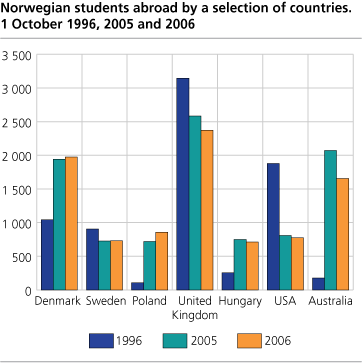Content
Published:
This is an archived release.
More students in university colleges
223 000 students were enrolled at tertiary institutions the autumn semester of 2006. While fewer students enrolled at universities and specialised university institutions, there were more students in university colleges.
Numbers from 2006 show an increase of 1700 students in university colleges compared with 2005. The increase is mainly caused by a higher enrolment of women. Most of these women chose to study at one of the state university colleges.
Simultaneously with the increase in enrolments in the university colleges, there were a corresponding reduction of enrolled students in the universities and specialised university institutions, where men formed most of the decline.
Fewer chose to study in Great Britain and Australia
Compared with 2005, there are 600 fewer Norwegians studying abroad in 2006. This form a decline of almost five per cent.
The school year 1993/1994 the Loan Fund expanded its support, from normally covering only education in Europe, USA and Canada, to cover all countries. This especially made Australia popular among Norwegian students the following years (see also publication on students abroad ). However, in 2006, there were 20 per cent fewer Norwegians studying in Australia with support from the Loan Fund, compared with 2005. Compared with 2004, the decline is 39 per cent.
In Great Britain there is a decline in the number of Norwegian students of 8 per cent compared with 2005. Despite of the decline, Great Britain and Australia, together with Denmark, are the most popular countries for Norwegian students. Among the 11 700 Norwegian students studying abroad in 2006, 20 per cent chose to study in Great Britain, 17 per cent in Denmark, and 14 per cent in Australia.
Poland has had the biggest increase in number of Norwegian students from 2005, with 19 per cent( 1 ). Compared with 2004 the increase is 60 per cent( 1 ) (see also previous publication ). In the rest of Europe” the number of Norwegian students has increased 24 per cent( 1 ) compared with 2005. Still, all these countries are far less popular than the most popular countries among Norwegian students.
Almost unchanged attendance in ‘Natural Sciences, Vocational and Technical Subjects’
Since 2000, the European Union has had a strategy (the Lisbon Strategy), with the objective to make the European Union the most competitive, and dynamic knowledge-based economy in the world within 2010 (more on the Lisbon Strategy ). One of the objectives is increasing the number of graduates in mathematics, science and technology with at least 15 per cent within 2010. One indicator used to monitor this is number of students enrolled in these subjects as a proportion of the total student number in tertiary education. The 2006 numbers show that the number of Norwegian students in tertiary education in ‘Natural Sciences, Vocational and Technical Subjects’ is nearly unchanged since 2005.
Another objective in the Lisbon Strategy is to decrease the level of gender imbalance in these areas of study. Even tough men still form the majority of students in this field of study in Norway, the numbers show a small increase in the share of women.
The last 20 years there has been a majority of women in tertiary education in Norway. In 2006 the men only made the majority in ‘Natural Sciences, Vocational and Technical Subjects’ and “Transport and communications, safety and security”.
Fewer students in “Humanities and Arts”
In “Humanities and Arts” the number of students are decreased from 32 300 in 2005 to 29 600 in 2006. This is equal to a reduction of 8 per cent. The decline is distributed between 1100 men and 1600 women.
(1)Corrected 06.08.2007 at 10.30 a.m.
Tables:
- Table 1 Students in tertiary education in Norway and Norwegian students abroad, by gender, type of college, ownership and educational institution. 1 October 1996, 2005 and 2006
- Table 2 Students in tertiary education in Norway and Norwegian students abroad, by gender, age and type of college. 1 October 2006. Absolute figures and per cent
- Table 3 Students in tertiary education in Norway and Norwegian students abroad, by gender and field of education. 1 October 1996, 2005 og 2006
- Table 4 Students in Norway and Norwegian students abroad, by gender and county of residence at the age of 16. 1 October 1996, 2005 and 2006.
- Table 5 Norwegian students in tertiary education abroad, by gender and Countries of destination. 1 October 1996, 2005 and 2006
Contact
-
Geir Nygård
E-mail: geir.nygard@ssb.no
tel.: (+47) 48 15 13 44
-
Maj-Lisa Lervåg
E-mail: maj-lisa.lervag@ssb.no
tel.: (+47) 45 68 84 72

